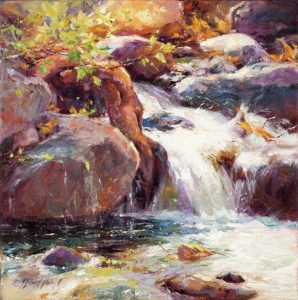Dear Artist,
Jacob Collins is a New York artist and art educator whose avowed goal is to be “an old-fashioned painter.” Working from life — nudes, still life, figures — in his dark and purpose-lit studio, he laboriously draws and draws out the character of his subjects by the time-honoured method of explore, erase and refine. A modern-day Rembrandt, he eschews the unskilled methodology of many among the current avant-garde.
In a recent issue of The New Yorker, the wide-ranging writer and art critic Adam Gopnik, whose kids happen to go to the same school as Collins’s, tells about learning to draw by Collins’s side.
Gopnik, armed only with a graduate degree in art history, admits he likes to draw but does it very badly. “For all the years I’d spent talking about pictures,” Gopnik writes, “the truth was that I had no idea how to draw or what it felt like to do it. I would mistrust a poetry critic who couldn’t produce a rhyming couplet. Could one write about art without knowing how to draw?”
People who write about art are often those who are merely confused by it. Confusion, in my experience, seldom dampens enthusiasm. I was once on the board of a highly respected art school where all of the board members but one were lawyers. Further, there’s the frequently noted situation where many of our top collectors are scientists and mathematicians. And then again, why do I collect vintage cars? I’m so totally incompetent at their maintenance that I’m disgraced by even the mildly-talented among my mechanical friends. FYI, I bought another car yesterday, but I digress.
Gopnik, with great insight, analyzes his own desire to draw and Collins’s facility at it. “Drawing is one of those things which sit on the uneasy bending line between instinct and instruction,” Gopnik writes, “where seeming perversity eventually trumps pleasure as the card players and the kibitzers interact and new thrills are sought.” We have no idea just how ‘bad’ Gopnik’s drawings are, even while he refers to their badness frequently throughout the article. But that’s not the point. It is respect that he gains — respect for an elusive art. And we who draw daily get a bit of respect, too.
Best regards,
Robert
PS: “Drawing, I now think, need not be the bones of art, but skill must always be the skeleton of accomplishment.” (Adam Gopnik)
Esoterica: I’ve encouraged both myself and others to experience the joy of drawing. It may be separate from painting, but it is certainly key to much that is great in painting. To find a line, to make it work, to really see it and know it holds life and energy or is pregnant with feeling, is to experience a kind of excitement that even sensitive observers cannot truly know. If only for the forward march of our own character, we need to fill our sketchbooks.
This letter was originally published as “Learning to draw” on July 19, 2011.
 The Letters: Vol. 1 and 2, narrated by Dave Genn, are available for download on Amazon, here. Proceeds of sales contribute to the production of The Painter’s Keys.
The Letters: Vol. 1 and 2, narrated by Dave Genn, are available for download on Amazon, here. Proceeds of sales contribute to the production of The Painter’s Keys.
“Drawing is still the bottom line.” (Robert Genn)
Featured Workshop
Learn to make water look wet, reflective and splashy! Painting water that looks wet requires some basic knowledge of the dynamics of how water moves and how objects are reflected in its mirror surface. Techniques will be demonstrated to address the various puzzles with which the artist is faced when painting this stunning, fascinating and challenging subject!
This workshop takes place at Port Townsend School of the Arts, 2 hours’ drive from Seattle. For more information, and to register, visit our website: ptarts.org
Julie Gilbert Pollard’s workshop is limited to 12 participants. Save your place today!
Registration deadline: June 5.
Featured Artist
Robert’s technique includes a tradition of strong design with patterns of color and form, with a pervasive sense of personal style. Grand themes are transposed onto small panels and larger canvases in a manner similar to members of the Group of Seven. Most of Robert’s work is in acrylic. He has also done considerable work in oils, watercolour, and silk screen printing.








9 Comments
Great repost of Robert’s article. Drawing is the bones of creating successful 2D works no matter the medium used. Jacob Collins is a current day master of this.
Drawing! Oh my yes! In later years I set out to become an oil painter. But first, I believed I needed to learn how to draw. And I was right. Without the boring details, in a few short evening classes I went from “I can’t draw anything” to “There isn’t anything I can’t draw”. Drawing is a technical skill and technical skills can be learned. The course was based on the book “Drawing on the Right Side of the Brain” by Betty Edwards. (It probably infringed on copyright but I didn’t know that.) Anyhow, Betty is in her 90s and it seems her son is now teaching her methods. Not taking anything away from Jacob Collins and Adam Gopnik, Betty’s methodology is definitely a way to fast track. I highly recommend it. http://www.drawright.com/band-horizon
Best & Good Luck,
Verna
I find it curious that even if Collins pursues a certain traditional essence, the model is shaved, rather than showing the traditional beauty of her follicular nature.
There has to be more to drawing than technical skill. Art is more than craft. The idea of drawing as being no more than technical accuracy is what led much nineteenth century art in France and Britain to become moribund.
Could Cezanne draw? Could van Gogh? Could Matisse? I would say an emphatic yes in all cases. It all depends what you mean by drawing, which I take to be evidence of a personal and truthful response to visual experience. It doesn’t have to conform to an academic norm which simply leads to everybody’s drawing looking like everybody else’s. A drawing has to speak of the personal or it is no more than a display of technique which may inspire admiration but will rarely move us.
I speak as someone who had five years at art school (back in the last millenium) when we drew every day and the importance of sketchbooks was dinned into us – I am just starting on number 61.
Completely agree with Frank. While there is a fundamental technical aspect to drawing, which is important, the ability to convey a certain style, an emotion and/or creativity, to name a few is equaly as important.
A good friend of mine is a fantastic chef. He doesn’t own a restaurant (he’s a chemist), but he enjoys creating meals without recipes, and no two are ever alike. I think of art in the same way. There are techniques that can be learned, instructions to follow that will lead to a satisfactory work, but technique alone is no substitute for creativity. I am just an amateur, but what I have learned about painting and drawing is that I have to live inside them in order to feel as if I’ve done something more than follow a recipe.
Many times the acedemic approach ends up like everybody is playing the same song over and over. However, in the case of Jacob Collins, I think his work transcends the acedemic and gives us a deep feeling.
It appears that many here equate technical facility with creative inspiration. Could it be that they are two different things? The ability to draw the line is not the same as knowing which line to draw.
Bravo Douglas, bravo! My sentiments exactly. In the Betty Edwards-based drawing class to which I referred above, we all drew a man sitting on a chair (on a 4 planed grid). One of the students in our class who was a trained draftsman went home and returned the next week with a re-worked and absolutely perfectly rendered drawing of the man sitting on the chair. It was stunning in its technical perfection but the lack of ’emotion’ in the drawing was palpable – even to me who was just starting out. So I would concur with your ‘wondering’, Douglas, that technical facility and creative inspiration are perhaps two different things. I still say anyone can learn to draw using Betty Edwards’ methodology.